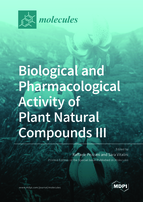Biological and Pharmacological Activity of Plant Natural Compounds III
A special issue of Molecules (ISSN 1420-3049). This special issue belongs to the section "Natural Products Chemistry".
Deadline for manuscript submissions: closed (15 December 2022) | Viewed by 40017
Special Issue Editors
2. Associazione Italiana per la Ricerca Oncologica di Base, Padova, Italy
Interests: plant medicinal chemistry; phytotherapy research; oncology; preclinical research; endocrinology
Special Issues, Collections and Topics in MDPI journals
Interests: crop protection; plant diseases; bioactivity; phytochemistry; ethnopharmacology; natural products
Special Issues, Collections and Topics in MDPI journals
Special Issue Information
Dear Colleagues,
Given the success of the previous editions, we have decided to propose a third edition of the Special Issue entitled “Biological and Pharmacological Activity of Plant Natural Compounds”. The topic is the same, and so is the aim, to explore novel, uncommon, alternative uses of plant-derived compounds in human health and in preclinical settings. In addition, basic research on biological, pharmacological, biochemical, etc. properties of plants is welcome. Of course, both articles and reviews and collaborative research works can be prepared and submitted.
Prof. Dr. Raffaele Pezzani
Prof. Dr. Sara Vitalini
Guest Editors
Manuscript Submission Information
Manuscripts should be submitted online at www.mdpi.com by registering and logging in to this website. Once you are registered, click here to go to the submission form. Manuscripts can be submitted until the deadline. All submissions that pass pre-check are peer-reviewed. Accepted papers will be published continuously in the journal (as soon as accepted) and will be listed together on the special issue website. Research articles, review articles as well as short communications are invited. For planned papers, a title and short abstract (about 100 words) can be sent to the Editorial Office for announcement on this website.
Submitted manuscripts should not have been published previously, nor be under consideration for publication elsewhere (except conference proceedings papers). All manuscripts are thoroughly refereed through a single-blind peer-review process. A guide for authors and other relevant information for submission of manuscripts is available on the Instructions for Authors page. Molecules is an international peer-reviewed open access semimonthly journal published by MDPI.
Please visit the Instructions for Authors page before submitting a manuscript. The Article Processing Charge (APC) for publication in this open access journal is 2700 CHF (Swiss Francs). Submitted papers should be well formatted and use good English. Authors may use MDPI's English editing service prior to publication or during author revisions.
Keywords
- plant natural products
- biological and biochemical activity
- phytotherapy
- plant medicinal chemistry
- plant extracts
- phytochemicals
- natural medicine








